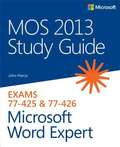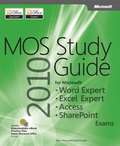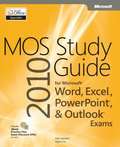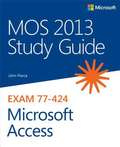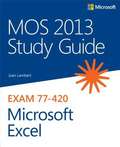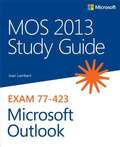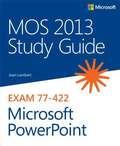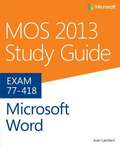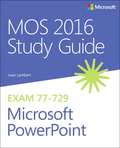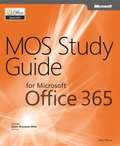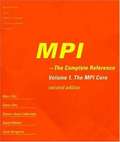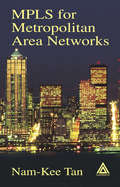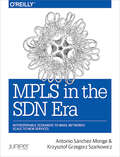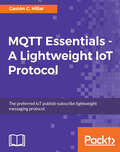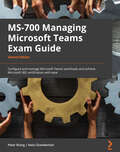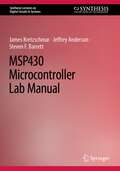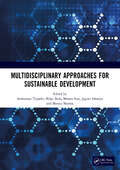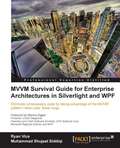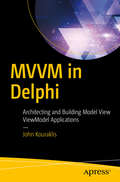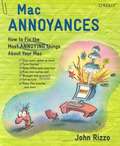- Table View
- List View
MOS 2010 Study Guide for Microsoft® Word Expert
by John PierceDemonstrate your expertise with Microsoft Word by earning a MOS 2010 certification. This Study Guide is designed to help you practice and prepare for Exam 77-887: Word 2010 Expert, and features:Full objective-by-objective review Procedures and hands-on practice tasks Ready-made, downloadable practice files Exam-discount Use the in-depth exam prep, practice, and review to help further advance your proficiency with Word 2010--and earn the expert-level credential that proves it! NOTE: This same content is also available as part of the MOS 2010 Study Guide for Microsoft Word Expert, Excel Expert, Access, & SharePoint Exams (ISBN 9780735657885)
MOS 2010 Study Guide for Microsoft® Word Expert, Excel® Expert, Access®, and SharePoint®
by John Pierce Geoff EvelynDemonstrate your expertise with Microsoft Office! Designed to help you practice and prepare for four Microsoft Office Specialist (MOS) exams, this all-in-one study guide features: Full, objective-by-objective exam coverage Easy-to-follow procedures and illustrations to review essential skills Hands-on practice tasks to apply what you've learned; files included Online pre-test to assess your readiness Use the in-depth exam prep, practice, and review to help advance your proficiency with Microsoft Office--and earn the credential that proves it! Exams covered: 77-887: MOS: Microsoft Office Word 2010 Expert 77-888: MOS: Microsoft Office Excel 2010 Expert 77-885: MOS: Microsoft Office Access 2010 77-886: MOS: Microsoft SharePoint 2010 Companion Content includes: Practice files for each exam Fully searchable eBook Sample chapters from five STEP BY STEP books from Microsoft Press (TBD) Additional eBooks and resources Special Offer: Exam discount plus free online pre-test! Get 25% off your MOS exam fee and a free Microsoft Official Pre-Test from Certiport Use the pre-test to assess your skill level and get feedback on your results, including a custom learning plan See details on the Certiport offer page inside
MOS 2010 Study Guide for Microsoft® Word, Excel®, PowerPoint®, and Outlook®
by Joan Lambert Joyce CoxDemonstrate your expertise with Microsoft Office 2010! This all-in-one guide is designed to help you practice and prepare for the four core Microsoft Office Specialist (MOS) exams. With the MOS 2010 Study Guide, you get full, objective-by-objective coverage for: Exam 77-881: Microsoft Word 2010 Exam 77-882: Microsoft Excel 2010 Exam 77-883: Microsoft PowerPoint 2010 Exam 77-884: Microsoft Outlook 2010 Use the book's easy-to-follow procedures and illustrations to review the essential skills measured by the MOS exams. And you can apply what you've learned hands-on--using the downloadable files for all the book's practice tasks.
MOS 2013 Study Guide for Microsoft Access
by John PierceDemonstrate your expertise with Microsoft Office! Designed to help you practice and prepare for the 2013 Access Microsoft Office Specialist (MOS) exam, this all-in-one study guide features: Full, objective-by-objective exam coverage Easy-to-follow procedures and illustrations to review essential skills Hands-on practice tasks to apply what you've learned; files included Online pre-test to assess your readiness Use the in-depth exam prep, practice, and review to help advance your proficiency with Microsoft Office--and earn the credential that proves it!
MOS 2013 Study Guide for Microsoft Excel
by Joan LambertDemonstrate your expertise with Microsoft Office! Designed to help you practice and prepare for the 2013 Excel Microsoft Office Specialist (MOS) exam, this all-in-one study guide features: Full, objective-by-objective exam coverage Easy-to-follow procedures and illustrations to review essential skills Hands-on practice tasks to apply what you've learned; files included Online pre-test to assess your readiness Use the in-depth exam prep, practice, and review to help advance your proficiency with Microsoft Office--and earn the credential that proves it!
MOS 2013 Study Guide for Microsoft Excel Expert
by Mark DodgeDemonstrate your expertise with Microsoft Office! Designed to help you practice and prepare for the 2013 Excel Expert Microsoft Office Specialist (MOS) exams, this all-in-one study guide features: Full, objective-by-objective exam coverage Easy-to-follow procedures and illustrations to review essential skills Hands-on practice tasks to apply what youâ TMve learned; files included Online pre-test to assess your readiness Use the in-depth exam prep, practice, and review to help advance your proficiency with Microsoft Officeâ "and earn the credential that proves it!
MOS 2013 Study Guide for Microsoft Outlook
by Joan LambertDemonstrate your expertise with Microsoft Office! Designed to help you practice and prepare for the 2013 Outlook Microsoft Office Specialist (MOS) exam, this all-in-one study guide features: Full, objective-by-objective exam coverage Easy-to-follow procedures and illustrations to review essential skills Hands-on practice tasks to apply what you've learned; files included Use the in-depth exam prep, practice, and review to help advance your proficiency with Microsoft Office--and earn the credential that proves it!
MOS 2013 Study Guide for Microsoft PowerPoint
by Joan LambertDemonstrate your expertise with Microsoft Office! Designed to help you practice and prepare for the 2013 PowerPoint Microsoft Office Specialist (MOS) exam, this all-in-one study guide features: Full, objective-by-objective exam coverage Easy-to-follow procedures and illustrations to review essential skills Hands-on practice tasks to apply what you've learned; files included Use the in-depth exam prep, practice, and review to help advance your proficiency with Microsoft Office--and earn the credential that proves it!
MOS 2013 Study Guide for Microsoft Word
by Joan LambertDemonstrate your expertise with Microsoft Office! Designed to help you practice and prepare for the 2013 Word Microsoft Office Specialist (MOS) exam, this all-in-one study guide features: Full, objective-by-objective exam coverage Easy-to-follow procedures and illustrations to review essential skills Hands-on practice tasks to apply what you've learned; files included Use the in-depth exam prep, practice, and review to help advance your proficiency with Microsoft Office--and earn the credential that proves it!
MOS 2016 Study Guide For Microsoft Powerpoint
by Joan LambertAdvance your everyday proficiency with PowerPoint 2016. And earn the credential that proves it! Demonstrate your expertise with Microsoft PowerPoint! Designed to help you practice and prepare for Microsoft Office Specialist (MOS): PowerPoint 2016 certification, this official Study Guide delivers: In-depth preparation for each MOS objective Detailed procedures to help build the skills measured by the exam Hands-on tasks to practice what you've learned Practice files and sample solutions Sharpen the skills measured by these objectives: Create and manage presentations Insert and format text, shapes, and images Insert tables, charts, SmartArt, and media Apply transitions and animations Manage multiple presentations About MOS A Microsoft Office Specialist (MOS) certification validates your proficiency with Microsoft Office programs, demonstrating that you can meet globally recognized performance standards. Hands-on experience with the technology is required to successfully pass Microsoft Certification exams.
MOS Study Guide for Microsoft® Office 365
by John PierceDemonstrate your expertise with Microsoft Office 365 by earning a MOS certification. This Study Guide is designed to help you prepare for MOS Exam 77-891: Microsoft Office 365, and features:Full objective-by-objective review Easy-to-follow procedures and hands-on tasks Exam-discount offer from Certiport Use the in-depth exam prep, practice, and review to help advance your proficiency with Office 365--and earn the credential that proves it.
MPI: The Complete Reference (Volume 2, The MPI-2 Extensions)
by Marc Snir William Gropp Steven Huss-Lederman Bill Nitzberg William Saphir Andrew Lumsdaine Ewing LuskSince its release in summer 1994, the Message Passing Interface (MPI) specification has become a standard for message-passing libraries for parallel computations. There exist more than a dozen implementations on a variety of computing platforms, from the IBM SP-2 supercomputer to PCs running Windows NT.
MPLS for Metropolitan Area Networks
by Nam-Kee TanMPLS for Metropolitan Area Networks demonstrates solutions provided by MPLS features. The text opens with an overview of metro networks and MPLS. It examines traffic engineering issues, focusing on fundamental TE concepts and network control. The author then discusses how MPLS can bring increased reliability to Metropolitan Area Networks (MANs), and concludes with a detailed analysis of the service aspects of MANs. Topics reviewed include L3 and L2 MPLS VPNs, geographically dispersed Ethernet multipoint services, virtual private LAN services (VPLS), and the integrated services (IntServ) and differentiated services (DiffServ) QoS models with respect to MPLS.
MPLS in the SDN Era: Interoperable Scenarios to Make Networks Scale to New Services
by Antonio Sanchez Monge Krzysztof Grzegorz SzarkowiczHow can you make multivendor services work smoothly on today’s complex networks? This practical book shows you how to deploy a large portfolio of multivendor Multiprotocol Label Switching (MPLS) services on networks, down to the configuration level. You’ll learn where Juniper Network's Junos, Cisco's IOS XR, and OpenContrail, interoperate and where they don’t.Two network and cloud professionals from Juniper describe how MPLS technologies and applications have rapidly evolved through services and architectures such as Ethernet VPNs, Network Function Virtualization, Seamless MPLS, Egress Protection, External Path Computation, and more. This book contains no vendor bias or corporate messages, just solid information on how to get a multivendor network to function optimally.Topics include:Introduction to MPLS and Software-Defined Networking (SDN)The four MPLS Builders (LDP, RSVP-TE, IGP SPRING, and BGP)Layer 3 unicast and multicast MPLS services, Layer 2 VPN, VPLS, and Ethernet VPNInter-domain MPLS ServicesUnderlay and overlay architectures: data centers, NVO, and NFVCentralized Traffic Engineering and TE bandwidth reservationsScaling MPLS transport and servicesTransit fast restoration based on the IGP and RSVP-TEFIB optimization and egress service for fast restoration
MQTT Essentials - A Lightweight IoT Protocol: The preferred IoT publish-subscribe lightweight messaging protocol
by Gastón C. HillarSend and receive messages with the MQTT protocol for your IoT solutions.Key FeaturesMake your connected devices less prone to attackers by understanding practical security mechanismsDive deep into one of IoT’s extremely lightweight machines to enable connectivity protocol with some real-world examplesLearn to take advantage of the features included in MQTT for IoT and Machine-to-Machine communications with complete real-life examplesBook DescriptionThis step-by-step guide will help you gain a deep understanding of the lightweight MQTT protocol. We’ll begin with the specific vocabulary of MQTT and its working modes, followed by installing a Mosquitto MQTT broker. Then, you will use best practices to secure the MQTT Mosquitto broker to ensure that only authorized clients are able to publish and receive messages. Once you have secured the broker with the appropriate configuration, you will develop a solution that controls a drone with Python. Further on, you will use Python on a Raspberry Pi 3 board to process commands and Python on Intel Boards (Joule, Edison and Galileo). You will then connect to the MQTT broker, subscribe to topics, send messages, and receive messages in Python. You will also develop a solution that interacts with sensors in Java by working with MQTT messages. Moving forward, you will work with an asynchronous API with callbacks to make the sensors interact with MQTT messages. Following the same process, you will develop an iOS app with Swift 3, build a website that uses WebSockets to connect to the MQTT broker, and control home automation devices with HTML5, JavaScript code, Node.js and MQTT messagesWhat you will learnUnderstand how MQTTv3.1 and v3.1.1 works in detailInstall and secure a Mosquitto MQTT broker by following best practicesDesign and develop IoT solutions combined with mobile and web apps that use MQTT messages to communicateExplore the features included in MQTT for IoT and Machine-to-Machine communications Publish and receive MQTT messages with Python, Java, Swift, JavaScript, and Node.jsImplement the security best practices while setting up the MQTT Mosquitto brokerWho this book is forThis book is a great resource for developers who want to learn more about the MQTT protocol to apply it to their individual IoT projects. Prior knowledge of working with IoT devices is essential.
MS-700 Managing Microsoft Teams Exam Guide: Configure and manage Microsoft Teams workloads and achieve Microsoft 365 certification with ease
by Nate Chamberlain Peter RisingA detailed guide to preparing for the MS-700 exam and earning associate-level Microsoft Teams administrator certificationKey FeaturesPlan and design your Microsoft Teams deploymentPrepare, implement, and manage policies for Microsoft Teams and for apps within TeamsWork with self-assessment questions and a mock exam and take the MS-700 certification exam with confidenceBook DescriptionExam MS-700: Managing Microsoft Teams tests your knowledge and competence in the deployment, management, and monitoring of Microsoft Teams features within the Microsoft 365 platform. This book will teach you how to effectively plan and implement the required services using both the Teams admin centre within Microsoft 365 and Windows PowerShell. Throughout the chapters, you'll learn about all the policies relating to messaging, teams, meetings, and more; get to grips with the settings; and explore configuration options that a Teams administrator would encounter in their day-to-day responsibilities. You'll also discover best practices for rolling out and managing Teams services for users within your Microsoft 365 tenant as you explore each objective in detail. By the end of this Microsoft Teams book, you'll have covered everything you need to pass the MS-700 certification exam and have a handy, on-the-job desktop reference guide.What you will learnPlan and configure network settings and licensing for Microsoft TeamsPlan and configure security, compliance, and governance for Microsoft TeamsManage users and configure guest and external accessConfigure and manage Microsoft Teams devicesCreate and manage teams, channels, and core experiencesManage Phone System and numbers for Microsoft TeamsTroubleshoot audio, video, client, and environment issuesPractice with a mock exam with answers and explanationsWho this book is forThis book is for IT professionals who want to earn the Microsoft 365 Certified: Teams Administrator Associate certification. Familiarity with the principles of administering core features and services within a Microsoft 365 tenant and a basic understanding of Microsoft Teams features are needed. Prior knowledge of other Microsoft 365 workloads such as Security & Compliance will also be beneficial. To maximize the odds of passing the MS-700 exam, use this exam guide’s content and practice questions to prepare alongside practicing concepts first-hand when possible.
MS-700 Managing Microsoft Teams Exam Guide: Configure and manage Microsoft Teams workloads and achieve Microsoft 365 certification with ease, 2nd Edition
by Nate Chamberlain Peter RisingA detailed guide to preparing for the MS-700 exam and earning associate-level Microsoft Teams administrator certificationKey FeaturesPlan and design your Microsoft Teams deploymentPrepare, implement, and manage policies for Microsoft Teams and for apps within TeamsWork with self-assessment questions and a mock exam and take the MS-700 certification exam with confidenceBook DescriptionExam MS-700: Managing Microsoft Teams tests your knowledge and competence in the deployment, management, and monitoring of Microsoft Teams features within the Microsoft 365 platform. This book will teach you how to effectively plan and implement the required services using both the Teams admin centre within Microsoft 365 and Windows PowerShell. Throughout the chapters, you'll learn about all the policies relating to messaging, teams, meetings, and more; get to grips with the settings; and explore configuration options that a Teams administrator would encounter in their day-to-day responsibilities. You'll also discover best practices for rolling out and managing Teams services for users within your Microsoft 365 tenant as you explore each objective in detail.By the end of this Microsoft Teams book, you'll have covered everything you need to pass the MS-700 certification exam and have a handy, on-the-job desktop reference guide.What you will learnPlan and configure network settings and licensing for Microsoft TeamsPlan and configure security, compliance, and governance for Microsoft TeamsManage users and configure guest and external accessConfigure and manage Microsoft Teams devicesCreate and manage teams, channels, and core experiencesManage Phone System and numbers for Microsoft TeamsTroubleshoot audio, video, client, and environment issuesPractice with a mock exam with answers and explanationsWho this book is forThis book is for IT professionals who want to earn the Microsoft 365 Certified: Teams Administrator Associate certification. Familiarity with the principles of administering core features and services within a Microsoft 365 tenant and a basic understanding of Microsoft Teams features are needed. Prior knowledge of other Microsoft 365 workloads such as Security & Compliance will also be beneficial. To maximize the odds of passing the MS-700 exam, use this exam guide's content and practice questions to prepare alongside practicing concepts first-hand when possible.
MSP430 Microcontroller Lab Manual (Synthesis Lectures on Digital Circuits & Systems)
by Jeffrey Anderson Steven F. Barrett James KretzschmarThis book is a practical reference for using Texas Instruments MSP430 microcontrollers. It provides a series of hands-on laboratory exercises. The labs may be completed in a traditional laboratory setting or at home using the Digilent Analog Discovery 2 Test Instrument. This book can be used as a reference for planning future projects using the MSP430 microcontroller. The authors focus on applications of the main peripheral modules available on the MSP430 microcontroller – CPU clock, Basic Input/Output, Timer, Analog-to-Digital Converter. They also provide examples of how to develop Pulse Width Modulation signals, and how to use Interrupts.
MTS PYTHON-1 (SEC-101) First Semester FYBA, B.SC New NEP Syllabus - SPPU
by Hrishikesh V. Khaladkar Dr Nanasaheb M. Phatangare Dr Anil S. KhairnarThe comprehensive textbook titled “MTS: Python 1,” is tailored for first-year B.A./B.Sc. (Honours / Honours with Research) Mathematics students under the National Education Policy (NEP) 2020 syllabus for the academic year 2024-2025. It covers Python programming fundamentals, including topics such as installation, syntax, data types, conditional structures, loops, strings, functions, and advanced topics like modular programming, recursion, and lambda functions. The text provides structured explanations, practical exercises, and examples designed to build Python programming skills progressively. Additionally, it outlines potential real-world applications and project-based tasks for enhanced learning.
MULTIDISCIPLINARY APPROACHES FOR SUSTAINABLE DEVELOPMENT: International Conference on MULTIDISCIPLINARY APPROACHES FOR SUSTAINABLE DEVELOPMENT IN SCIENCE & TECHNOLOGY
by Monica Sharma Shilpi Birla Anshuman Tripathi Jagrati Sahariya Mamta SoniIn a world where the pace of technological advancement continues to accelerate, the imperative to ensure sustainable development has never been more pressing to address the same, the 1st International Conference on Multidisciplinary Approaches for Sustainable Development in Science & Technology (MASDST - 2024), took place at Manipal University Jaipur, Rajasthan, India, from 28th to 29th March 2024. Embracing the spirit of innovation and collaboration, this conference marks a significant milestone in the pursuit of sustainable solutions for our global challenges.
MVS TSO: CLIST and REXX ( Part #2)
by Doug LoweThis is still the best book we've seen for learning how to use the TSO commands that underlie ISPF. It is also an efficient introduction to CLIST and REXX.
MVS TSO: Concepts and ISPF (Part #1)
by Doug LoweThe first of a two-part revision, expanded to cover several major versions of TSO and ISPF released by IBM since publication of the first edition in 1984. This volume, Part 1, presents everything necessary to use TSO/ISPF for application programming. (Part 2 covers TSO commands and procedures.)
MVVM Survival Guide for Enterprise Architectures in Silverlight and WPF
by Muhammad Shujaat Siddiqi Ryan ViceThis book combines practical, real-world examples with all the background material and theory you need The concepts are explained with a practical LOB enterprise application that is gradually built through the course of this book. MVVM offers lots of design choices and the author shows examples of each of these approaches, by changing the code to achieve the same results. This book will be a valuable resource for Silverlight and WPF developers who want to fully maximize the tools with recommended best practices for enterprise development. This is an advanced book and you will need to be familiar with C#, the .Net framework, and Silverlight or WPF.
MVVM in Delphi
by John KouraklisDive into the world of MVVM, learn how to build modern Windows applications, and prepare for cross-platform development. This book introduces you to the right mindset and demonstrates suitable methodologies that allow for quick understanding of the MVVM paradigm. MVVM in Delphi shows you how to use a quick and efficient MVVM framework that allows for scalability, is of manageable complexity, and provides strong efficiency. One of the biggest challenges developers face is how to convert legacy and monolithic Delphi applications to the MVVM architecture. This book takes you on a step-by-step journey and teaches you how to adapt an application to fit into the MVVM design. What You Will Learn Gain the fundamentals of MVVM Visualize MVVM as a design philosophy Create easy-to-use frameworks for building your own MVVM applications Develop a methodology for converting legacy applications to the MVVM pattern Architect cross-platform and multi-lingual applications using the MVVM pattern Who This Book Is For Delphi developers with a good knowledge of Delphi or programming experience in a different language. In addition, this book is attractive to Delphi developers who want to modernize existing applications based on the MVVM design.
Mac Annoyances
by John RizzoAnyone who plugs in a Mac whether it's the proud owner of the very latest version or someone still tapping away on yesterday's model usually finds these machines to be an immensely popular and beneficial tool. Unfortunately, they can also be a royal pain in the neck. Any way you slice it, Macs still have a tendency to induce minor headaches at the most inopportune times. Mac Annoyances feels your pain. Developed precisely for the individual who can't live without a Mac yet can't deal with its fickle temperament Mac Annoyances provides solutions to scores of common problems faced by Mac owners. Contained within its pages are hidden (plus well-documented) tips, tricks, and workarounds designed to drastically improve specific problem-solving capabilities. The result: a significant enhancement of the overall user experience and a tremendous savings of time no matter which version you own. What does Mac Annoyances cover? What doesn't it cover is the more appropriate question. Hassles associated with Mac OS X, iLife, Mac hardware, and Microsoft Office (the mother of all annoyances) are all addressed in sharp detail. Also tackled: how to overcome problems related to specific applications such as iTunes, Microsoft Word, PowerPoint, and Apple's Mail program. Having trouble browsing the Web or searching with Google? Want to make your Mac a bit faster? Keyboard causing you trouble? These and dozens more annoyances like them are all dissected as well. Truth is, if you've experienced it, Mac Annoyances addresses it. Written by top-flight author and renowned Mac expert, John Rizzo, this book is a follow-up to the bestselling PC Annoyances . In keeping with the spirit of O'Reilly's Annoyances series, Rizzo adopts a sympathetic tone throughout the book that quickly ingratiates itself to readers. Rather than blaming Mac owners for possessing minimal technical savvy, Mac Annoyances takes them along for a fun-filled ride as they join forces and outsmart the system together.
